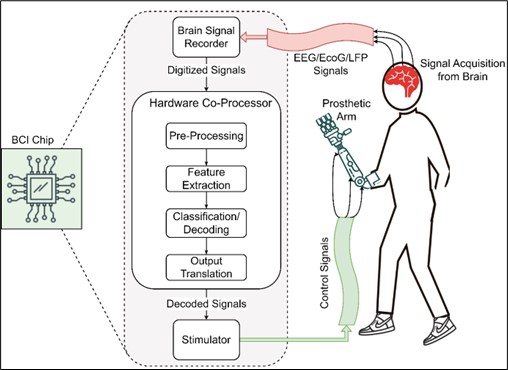Brain Co-Processors – A Moonshot Project in India
“The moonshot project brings together talents in many different areas to share a common vision – there’s AI, device development, electrode development, the animal aspects, neuroscience and the human clinical aspect. And in India, we have the resources, both on the engineering and the sciences side.”1
– Prof Rajesh Rao, Pratiksha Trust Distinguished Chair Professor, IISc

A moonshot project on brain co-processors has been initiated by the Brain, Computation, and Data Science group under the aegis of the Pratiksha Trust BCD Initiatives at IISc. The aim of this project is to develop invasive (implantable) or non-invasive brain co-processors to enhance or restore brain functions such as memory, attention, vision, and motor skills. Such co-processors involve decoding activity from neural recordings, processing it with an AI (artificial intelligence) algorithm implemented in software or hardware, and re-encoding signals back into the brain, either directly with neural stimulation/neurofeedback or by actuating external devices, such as prosthetic arms. The Figure shows a simplified view of a co-processor and its use-case of a motoric brain–computer interface.
The project derives its name from a 2019 paper on “neural co-processors” by Rajesh Rao, Cherng Jia and Elizabeth Yun Hwang Endowed Professor, and co-Director, Center for Neurotechnology at the University of Washington, and Pratiksha Trust Distinguished Chair Professor, Indian Institute of Science. The project commenced in October 2022, following a special call for proposals by the BCD Scientific Advisory Committee.
As a key element of novelty, the principal investigators (PIs) of the project have decided on cognitive rehabilitation of stroke patients as the targe medical application for the co-processor. The rationale is that stroke patients are a good model for exploring rehabilitation across mutliple sub-themes that were initially envisaged (decoding vision, decoding attention, decoding decisions, decoding actions, and low-power decoding in real-time). Considering the current state-of-the-art and open possibilities, they decided to organize into three teams, each focusing on a different aspect: A) conducting invasive intracranial EEG (electroencephalogram) recordings in epilepsy patients, B) developing non-invasive brain co-processors for stroke patients, and C) developing invasive (implantable) brain co-processors in animal models as a precursor for stroke patients. Each team will tackle one facet of the project with immediately realizable goals.
The actualization of the project vision entails collaboration between basic science researchers and clinicians (neurologists and neurosurgeons) from different institutes and hospitals across the country. For instance, to study the normal brain activity in epilepsy patients when they are not having seizure episodes, IISc researchers work with clinicians. During their resting times, patients could be asked to do simple vision, attention, and motor tasks that are similar to those proposed in the moonshot project1 (Team A). Similarly, clinicians’ involvement will be critical in the field trials of both non-invasive (Team B) and invasive (Team C) co-processors with stroke patients.
Broadly, the project is envisioned to be carried out in two stages. The first phase (years 1–5) – “MindReader” – will focus on developing technologies for recording neural activity at high densities from different brain regions and decoding mental states (perceptual, cognitive, and motor) by developing customised AI algorithms in software and hardware. The second phase (years 6–10+) – “MindHacker” – will focus on developing technologies for re-encoding signals back into the brain using a combination of recording and neurostimulation technologies.
References
- Report on Brain Co-processors by Krishnan Narayanan, Itihaasa Research and Digital
